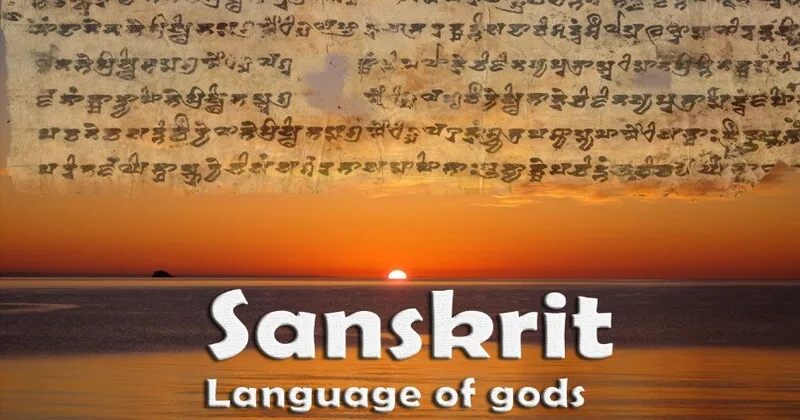A beautiful couplet from the poet Magha appears in his epic Shishupal Vadh defining the nature of beauty. “That which assumes a novelty for itself with each passing moment is an enchanting form (and consequently is a thing of beauty), it says. What he says about the beauty stands equally true for the language in which the epic is written – Sanskrit.
The language itself is a beauty. It is the highest and magnificent creation of human intelligence. It has survived ages and stands on a firm footing event today, ready for a flight in future befitting to its glorious past.

It has withstood countless attacks and nay-saying only to thrive in the minds and hearts of its innumerable aficionados, giving expression to their feelings – covering a plethora of emotions ranging from love, frustration, anger and sarcasm – even in this age of instant commentaries and opinions. As is well known, the origins of the Sanskrit language can be traced back to Vedas, the first chronicle of the human quest of knowledge even before spoken words were noted down. This origin goes so back in time that we have not been able to correctly find its starting point.
Since Vedas are generally supposed to be the first work of literature or knowledge in human history and consequently, Sanskrit automatically assumes the distinction of being first spoken word of the mankind. At least, that is the oldest oral tradition that has survived millenniums. The transcendental Sanskrit in Vedas transformed into a much organized grammatical text in the form of Upnishadas.
These philosophical treatises are also are steeped in antiquity and they too span a time frame of centuries. Then the Sanskrit was converted into a lingua franca in ancient India and became a common vehicle of expression for general population, going beyond geographical barriers. That is why Sanskrit works are found in abundance even in countries that are outside the borders of what we today call India.
It changed the hands, and more accurately mouths, to become chosen language of expression for every nameable name in any part of the country. All ancient kings from Mauryas to Chalukyas, from Cholas in Tamil Nadu to Vermans in Kerala and Yadavas in Karnataka had there inscriptions in Sanskrit. All poets be it Kalidas in Central India, Kalhan in Kashmir, Bhaas and Shankaracharya in Kerala or Bharavi in South India wrote in Sanskrit and were acclaimed in entire subcontinent.
So much so, that poet Paramanand, hailing from Maharashtra, composed Shrishivbharat, the biography of Chhatrapati Shivjaji, in Sanskrit “so that it reaches maximum number of people.” Even Chhatrapati Shivjaji’s son Chhatrapati Sambhaji, himself wrote a grand treatise titled Budhbhushanam in Sanskrit. Thus it is clear that the changing times did not affect the capability of the Sanskrit to bridge the communication barrier.
Sanskrit scholars found their way in Moghul darbar as well as British court. With the advent of European powers, and especially after independence, English gained more coinage. And yet Sanskrit thrived in temples, in schools as well as libraries.
A section of population, however minuscule, held on to it. The scene changed in 21st century as the new means of communication was added by your changing Technology. The computers, followed by internet and then platforms like blogs, social media, memes and videos heralded in new era wherein doors were threw open for Sanskrit to make its way among the youth.
Today, Sanskrit has crossed over from mere books and academies. It has captured imagination of a young breed of learners who embrace this old language as if it belongs to them. This is why we see a young Samashti Gubbi succeed in making people flock to the Cubbon Park in Bangalore to get weekly lessons in Sanskrit conversations.
We see Gandharva Sakhyam, a rock band, meting out Sanskrit numbers to packed houses in Pune, Mumbai and Nashik. We see entire villages turning into Sanskrit-speaking communities in Karnataka, Madhya Pradesh and elsewhere. We see a British singer Gaiea Sanskrit wins global audience by singing Sanskrit verses.
Even discounting the phrase ‘mother of all languages’ as a gross exaggeration, the language has remained an eternal source of vocabulary to a range of languages all over the world. Many languages in the Indo- European group derive their vocabulary from Sanskrit. About 40% of the people in the world speak languages that are heavily influenced by Sanskrit.
Most European languages such as Greek, Latin, German, Russian, Slavic, Baltic, etc., are influenced by Sanskrit. New high end products from corporate houses derive their names from Sanskrit.
Avanti, Vistara. Naming babies after exotic Sanskrit words has become such a trend that it may soon get the industry status. However, the role of Sanskrit is not confined to this.
It has not only survived but flourished in spite of all adversities. It transforms itself into various hues as the occasion demands. It has not stopped at being an ancient language of legacy knowledge.
It has become a means of exploring and delivery of modern knowledge. Sanskrit is ingrained with a quality described by the phrase ‘sanatanam, nitya nutanam’. It is timeless, but it ever-new.
This newness of the language is what gives it the worthiness. The detractors calling it ‘obsolete’ or ‘dead’ get proven wrong time and again because of this newness. No wonder then, Sanskrit remains as eternal as perennial.
.



















